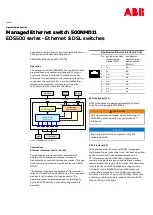
5
14306499.01 02/2019 EN
WIKA operating instructions, pressure switch, high adjustability of switch differential, model PSM-700
5.3 Electrical mounting
Integration of the pressure switch into the installation
Depending on the load characteristics, additional protective measures, e.g. for motor
protection, may be required.
DANGER!
Danger to life caused by electric current
Upon contact with live parts, there is a direct danger to life.
▶
The instrument may only be installed and mounted by skilled personnel.
Switch off the load circuit before starting work and secure against being switched on
unauthorised.
Cable preparation
The cable gland(s) used must be suitable for achieving an IP66 ingress protection. Size
the connecting cables for the largest current strength in the circuits and ensure sufficient
UV resistance and mechanical stability.
Recommendation: 4-wire cable with conductor cross-section of 0.5 ... 2.5 mm²
(AWG 20 ... 14). Fit wire ends with end splices. Conductor cross-section for end splices
with plastic sleeve ≤ 1.0 mm² and for end splices without plastic sleeve ≤ 1.5 mm².
Grounding
Include the ground connection in the inside of the instrument into the grounding concept
of the installation. Maximum conductor cross-section 4 mm².
Clamping the cable
6. Faults
CAUTION!
Physical injuries and damage to property and the environment
If faults cannot be eliminated by means of the listed measures, the instrument
must be taken out of operation immediately.
▶
Ensure that there is no pressure in the instrument and that the load circuit
is switched off. Protect against being put into operation accidentally.
▶
Contact the manufacturer.
▶
If a return is needed, please follow the instructions given in chapter 8.2
“Return”.
WARNING!
Physical injuries and damage to property and the environment caused
by media
Upon contact with hazardous media, harmful media (e.g. corrosive, toxic,
carcinogenic), and also with refrigeration plants and compressors, there is a
danger of physical injuries and damage to property and the environment.
Should a failure occur, aggressive media with extremely high temperature and
under high pressure or vacuum may be present at the instrument.
▶
For these media, in addition to all standard regulations, the appropriate
existing codes or regulations must also be followed.
For further information see chapter 1 “General information”.
Faults
Causes
Measures
Contact is not switching
in accordance with the
specification at the set
switch point/reset point
Electrical connection
is interrupted.
Carry out a continuity test on the electri-
cal connection lines.
Wiring error, e.g.
short-circuit
Check the pin assignment and correct it
if necessary
Electrical load
unsuitable.
Maintain the permissible electrical loads.
Contact contami-
nated.
Replace instrument
Switch differential
greater than the
switch point.
Carry out switch point setting with
matching test assembly, see chapter
5.2.
Vibrations
Decouple the instrument mechanically.
Short-circuit
Moisture in the
instrument.
Only use in ambient conditions for which
the ingress protection is suitable.
Contact chatter
(repeated, short-
duration opening and
closing).
Vibrations
Decouple the instrument mechanically.
1. Remove 4 screws and open cover
2. Remove the cover(s) of the electrical
connection(s)
3. Fit suitable cable gland(s) and feed in
the cable
4. Carry out the terminal assignment
according to the switching function,
tightening torque: Approx. 0.4 ... 0.5 Nm
5. Close the cover again and fix it with the
4 supplied screws.
5.4 Switch point setting
For an exact setting of the switch point, a test assembly with pressure generation and
pressure reference is needed. This test assembly can, for example, be realised with a
model CPG1500 precision digital pressure gauge and a model CPP30 hand test pump
(not shown).
1. Connect the model PSM-700 pressure switch, pressure reference and pressure
generation to a common pressure system.
2. Ensure that the switch point setting does not switch any loads on or off by mistake.
For visualisation of the switching function, an equivalent circuit, e.g. with a light bulb,
is recommended.
3. Drive slowly towards the required switch point pressure with the pressure generation
and pressure reference. Depending on the definition of the switch point, this must be
carried out on rising/falling pressure.
- If the instrument switches
before
the required switch point is reached, the switch
point setting must be turned clockwise (+) with the socket wrench.
- If the instrument switches
after
the required switch point is reached, the switch
point setting must be turned anticlockwise (-) with the socket wrench.
After each correction, release/build up the pressure and repeat this procedure until
the switch point is set correctly.
For instruments with adjustable switch differential directly in the connection, follow the
instructions in the next chapter.
Figure 1: Instrument mounting at the test assembly (also see 5.2 “Mechanical mounting”)
Figure 2: Screwing out the locking plate
Figure 3: Switch point setting
Figure 1
Figure 3
Figure 2
Hold instrument
Screw in and seal the process
connection


























